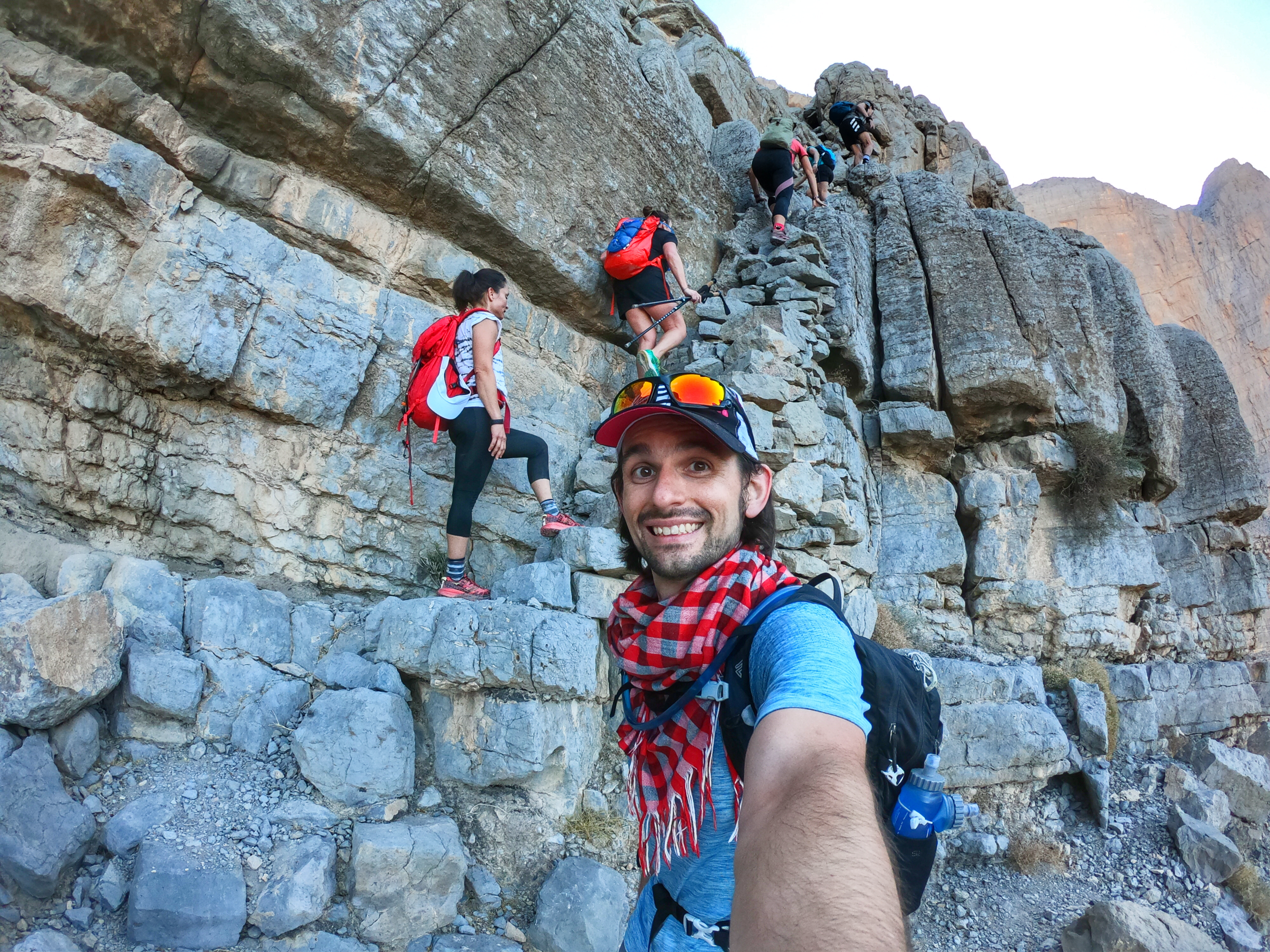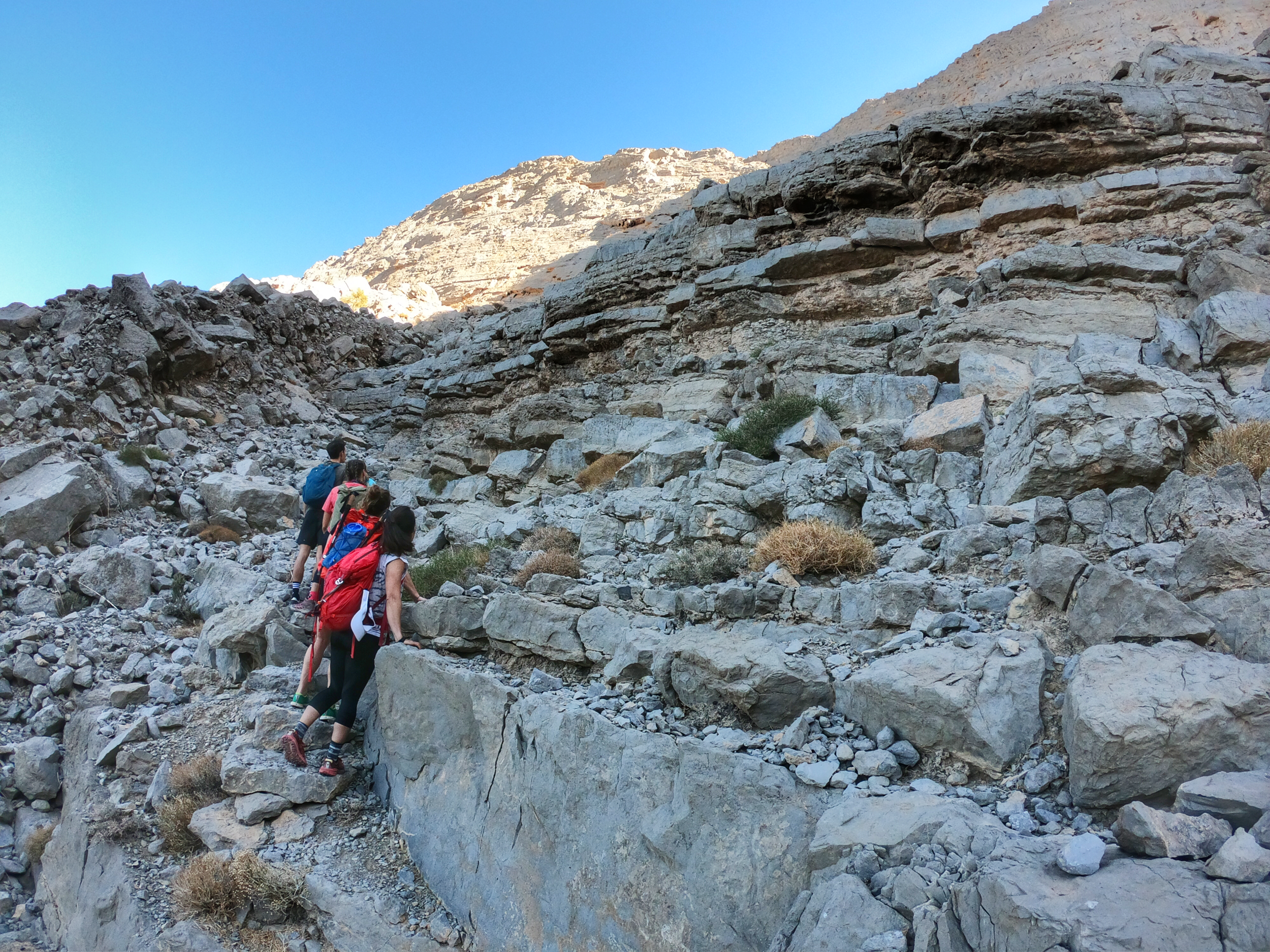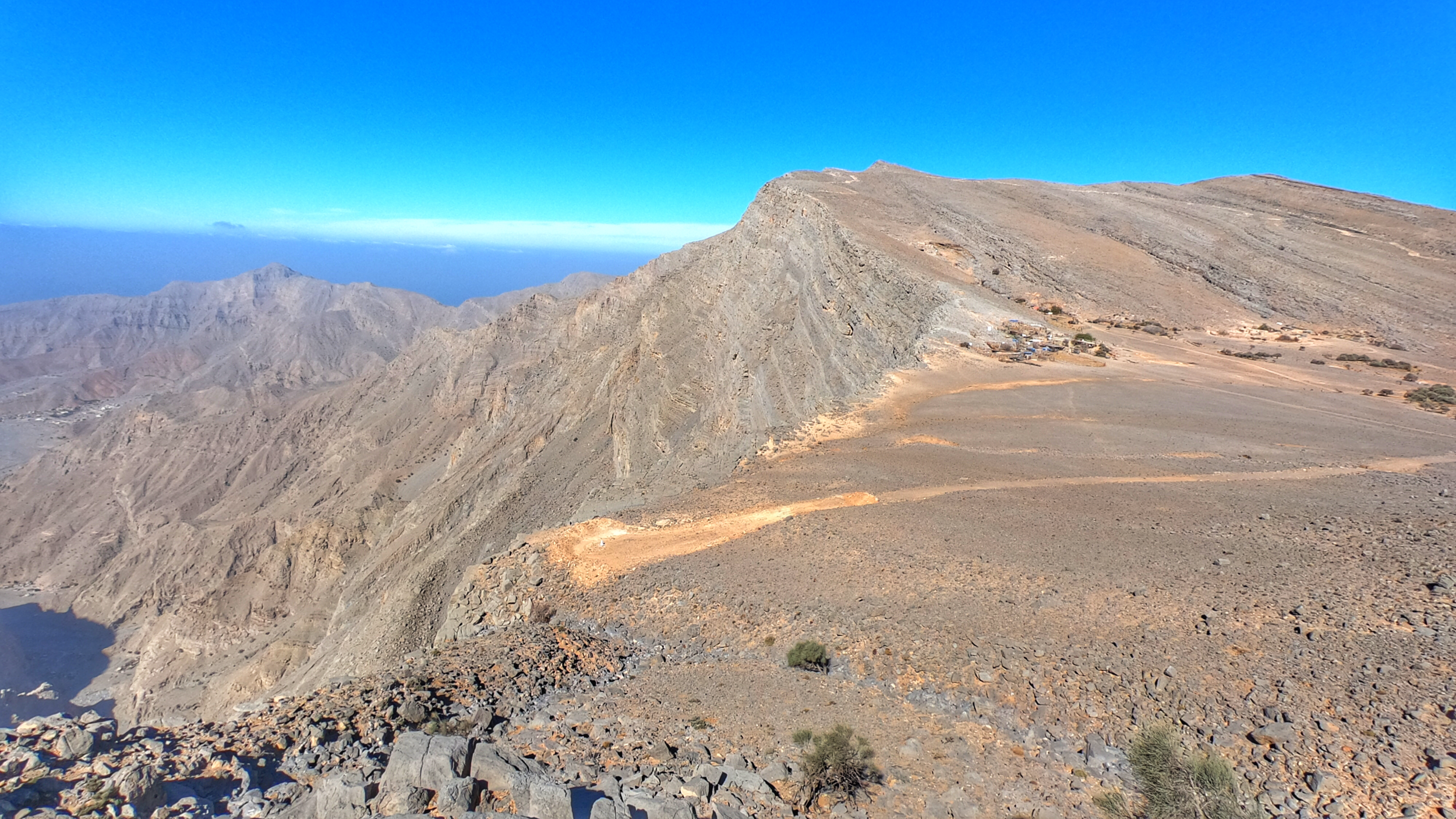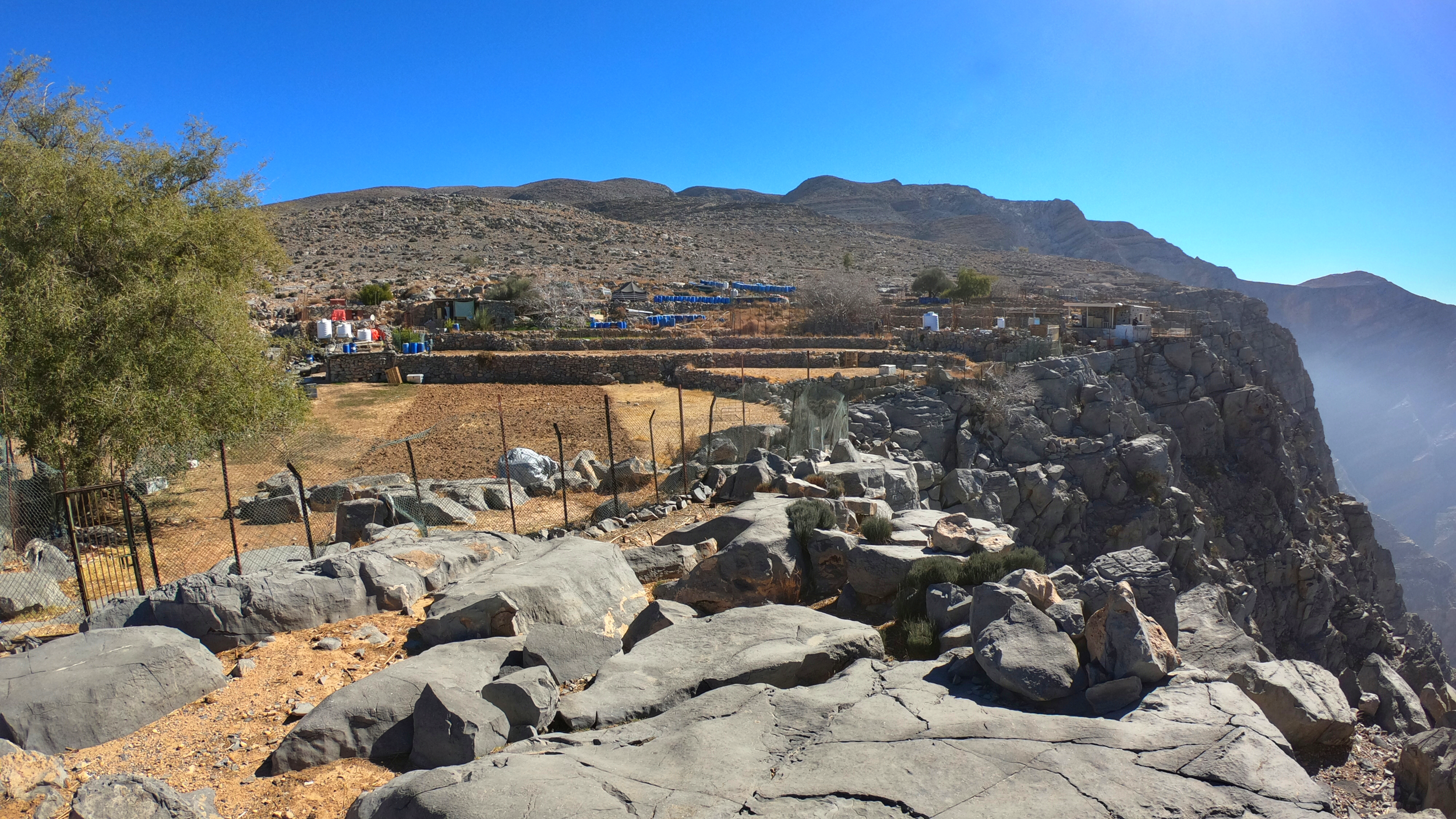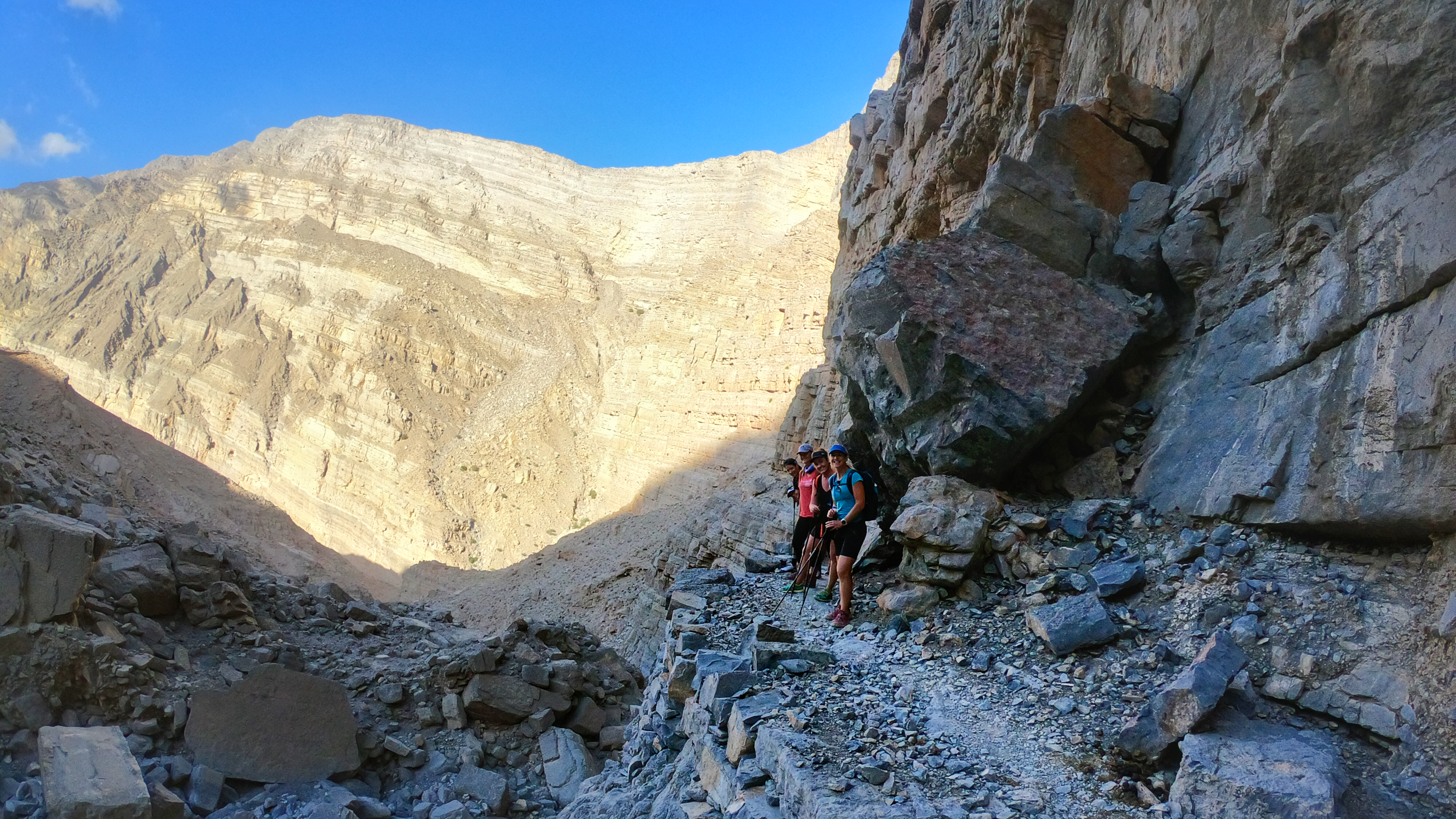Stairway to Heaven, Ras al Khaimah (UAE)
The Stairway to Heaven, or ‘The Stairway,’ is a somewhat infamous trail that scales a sheer cliff by means of a series of man-made stone staircases, which are, in fact, closer to ladders than any set of stairs that one might be familiar with in their own home. An old Shihuh trail, connecting the coast of Ras al Khaimah, 2 hours north of Dubai, with the villages and farms nestled on the high mountain plateau of Jebel Jais and Jebel al Harim and (literally) crossing the border into Oman, the stairways themselves make up a relatively short but extremely memorable section of what is a 21km loop.
I’ve wanted to take on this famed hike in the UAE ever since I heard mention of it years ago and whenever it looked as though I might be able to convince someone who had done it before to guide me, Summer would swing back round again and the idea of taking on a challenging, exposed mountain hike in the extreme heat and humidity of the UAE ‘hot season’ would scrub any such plans. The idea of tackling it on my own didn’t even register as a) I didn’t, until relatively recently, even know where it was, and b) knew, from speaking with people, that it was not to be underestimated, claiming lives as it has over the years and requiring mountain rescue to have to pluck some people off the cliff to safety after getting lost or otherwise in trouble.
So, it was with a sense of nervous excitement that I jumped at the chance to join my friend, Rachael, who has walked the Stairway route a number of times, and a few fellow outdoors enthusiasts, in finally seeing what all the fuss was about. And so it was that we made our way up to Wadi Ghailah dam, where I hopped into one of the group’s 4WDs for the 2.5km off-road drive down Wadi Litbah to the small collection of goat farms that marked the start of the trail. Setting out at 7.30am, our goal was to traverse the 21km loop in about 9 hours, arriving back before dark and so rendering our head-torches - part of the highly recommended essential kit to take along - redundant, although knowing full well that anything can happen and so there was always a chance that we might have to descend in the dark. Having, the week before, hiked most of the descent trail I knew full well just how steep, technical and precariously loose sections of it were even in full light and so the very idea of trying to walk down in the dark, even with torches, was a sobering one.
As we set out up the initial steady climb towards the ‘fork in the road’ that signalled the start of the actual stairway section, a local farmer was also setting off up the trail, driving a train of several donkeys, loaded up with various items, including building supplies. Given how narrow the trail is, with little to no opportunity to pass easily given how steep the drop-offs are, we had little choice but to set our pace to that of our hooved and amazingly fleet-footed equid companions. Anyone looking on might have assumed that we were part of a well-supplied expeditionary force, heading on up to scale some impossibly high peak Everest style. There were some moments of early jollity as the universality of a good ‘fart joke,’ supplied by a loud eruption from one of the aforementioned animals, had all chuckling, including the farmer himself. Eventually we arrived at the part of the narrow wadi where the donkeys forked right, heading up to the small farmsteads that dotted the slopes all the way to the top, and we went left, up, up and away towards the start of the actual stairways.
From any other vantage point, the scree slope that marked the first section of the climb, looked an impossible undertaking, appearing dangerously loose and at an incline that appeared not just lung-busting but unscaleable without ropes. The reality, however, was that whilst steep it was easily trekkable and before too long we found ourselves rising high above the wadi below and closer to the top of the imposingly high clifftops that curved round to encase the wadi below and that marked the border between the UAE and Oman. One of the key trail markers on this route is a tree that sits at the top of this scree slope and as we reached this, pausing to take in the impressive vista below, game faces were adopted as this was the point at which the steepness factor and exposure was to step up several notches. The Stairway to Heaven was next!
My main recollections of the climb proper were the following:
I tried to avoid looking down that much as whilst I am comfortable chucking myself out of aircraft with a parachute strapped to my back, when it comes to heights with no ‘safety system’ in place, such as scaling a sheer cliff by means of some very old stone ladders, I am as prone as any to a touch of vertigo. Upwards and onwards was my mantra.
There were indeed some sections that were dizzyingly exposed, principally the second stone staircase that curved out and round a corner, with absolutely nothing but a long drop below, but overall, the trail was surprisingly less narrow and terrifying than I had initially expected or feared. That is NOT to downplay how high and exposed this route is because it is. It is serious and we were incredibly fortunate to have a day that was both clear, sunny and still, with just the occasional gentle breeze. I would not have wanted to be up on those exposed sections of cliff with a wind blowing and especially gusts.
Sticking to the rock like a clingy limpet. One of the wonderful features of the rocks that make up the cliffs in that part of the UAE is just how textured they are, which made for wonderful friction and a plethora of very secure hand and footholds; exactly what one wants when traversing and climbing exposed areas of cliffside. I might have recorded some more footage of the more exposed sections of the trail had it not been for the fact that I was attached very, very firmly by way of all four of my limbs to the rock - had I been able to grow a prehensile tail and employ that as a fifth point of attachment I would have done! Not falling was my second mantra of the day.
Before very long we arrived at the final short incline and after a number of little switchbacks we all emerged onto the plateau at the top of the Stairway to Heaven, marked by the presence of a farm and were greeted by a friendly, food-obsessed black nanny goat who had clearly cottoned on, over the years, that with some degree of regularity humans would emerge from yonder, invariably electing to pause for a time at this spot and in doing so could be coerced into sharing some of their grub! Our initial attempts to repel such appeals were soon short-lived as once I pointed out that she was almost certainly pregnant, our collective attitude towards her lobbying for our lunch softened and she got her way.
The Stairway route traverses the border between the UAE and the Sultante of Oman and one way that it is evident that we had crossed into the neighbouring country, other than our cell phone provider now being Omani, was the presence of the red and white electricity pylons that are unmistakenly of Oman. Hikers ‘popping aross the border’ are tolerated by the authorities so long as they don’t wander too far into the country and so we stuck close to the cliff edge as we set out for part two of the hike, taking us up and along the mountain top towards the Woh village and the start of the descent. This section of the trail involved a surprising amount of climbing as one would be forgiven for thinking that once at the top of the Stairway that was, well, the top. Not so. We trekked onwards and upwards, arriving at the lookout point towards the summit of Jebel al Harim and the golf-ball-esque radar station that sits atop, before starting our descent to the village.
From the Woh village, which is essentially a collection of small terraced farms perched atop the rocky plateau opposite the summit of Jebel Jais, one has an unobstructed view all the way down to the Wadi Ghailah dam and through to the Arabian Gulf beyond. On a really clear day it is even possible to make out Iran in the far distance. The descent from here starts with a steep set of stone steps that soon merge into a long, winding and rocky trail that snakes down into the canyon, along it’s sheer walls and ultimately back to the fork before exiting along the same trail that initially brought us in.
Our overall time for the 21km loop was a little over 8.5 hours, so thankfully no need to break out our head-torches, and that was with at least an hour of combined stops along the way. A fantastic route and one that I am incredibly pleased to have finally completed, although I now very much wish to return and explore it some more.

